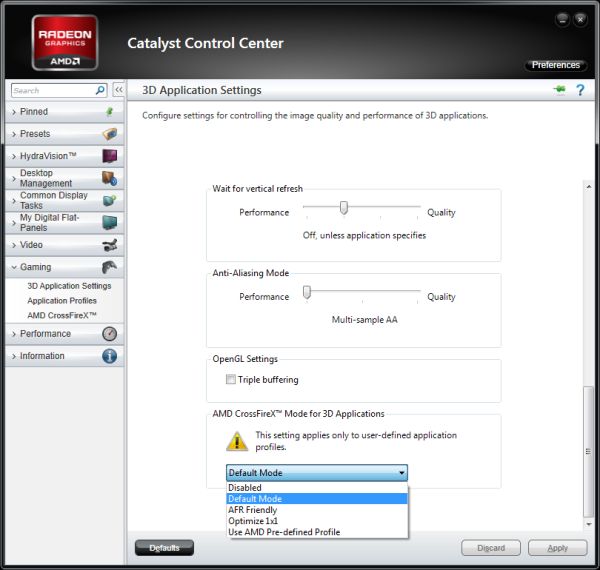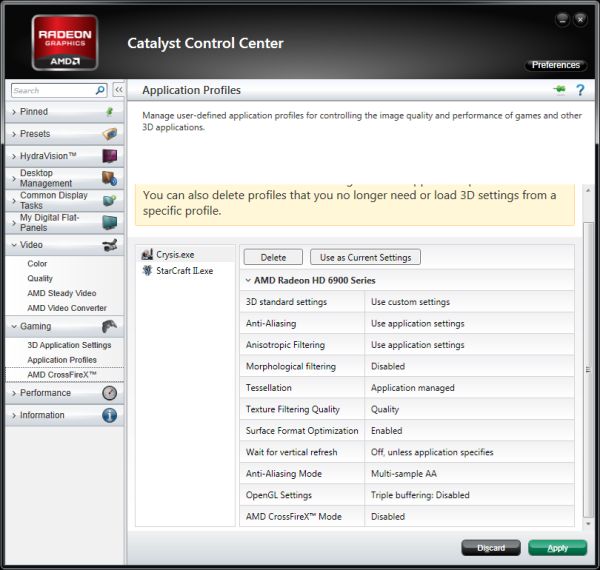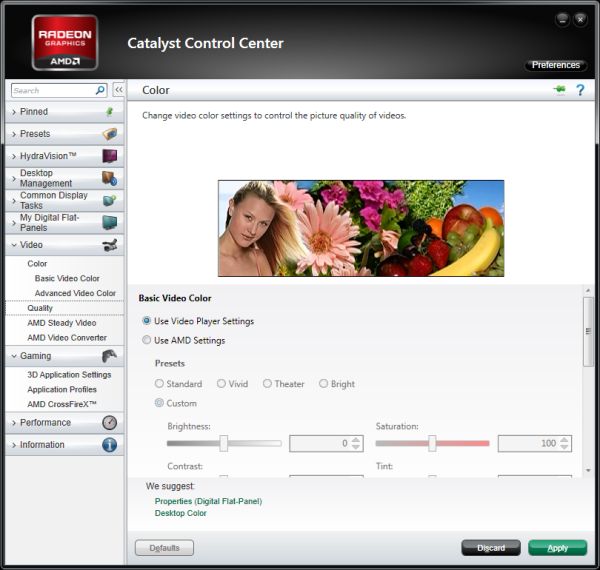AMD Releases Catalyst 12.1 Preview – Custom Application Profiles, HD3D CrossFire, & More
by Ryan Smith on December 13, 2011 1:00 AM ESTLater today AMD will be releasing the first preview for their Catalyst 12.1 driver set. AMD has been going through preview/beta drivers at a rapid pace in the last couple of months – we’ve seen 3 different 11.11 preview drivers in as many weeks – and as 11.12 nears, AMD is preparing for what 2012 and the Catalyst 12.x series will bring. It may sound like hyperbole to say that 2012 will be the biggest year yet for AMD’s Catalyst driver team, but it’s the truth. Graphics Core Next will be the biggest GPU architecture change for the company since R600 (2900XT) nearly 5 years ago, bringing with it a great deal of backend driver work that needs to be done, while the frontend team has their own goals and aspirations.
At the same time it’s going to give AMD the chance to close the book on 2011. 2011 brought with it some great developments out of the Catalyst team such as significant performance boosts for both Cayman (6900 series) GPUs and CrossFire across the board, while other groups delivered on more consumer-facing features such as SteadyVideo to go along with the launch of the Llano APU.
But 2011 also brought with it some technical debt and some reputational debt, all of which needs to be paid in 2012. AMD outright blew the launch of Rage by posting a faulty driver, Battlefield 3 in CrossFire mode did not work out of the box (i.e. without microstutter) even with nearly a month-long public beta and AMD’s close relationship with DICE, and CrossFire support for The Elder Scrolls V: Skyrim took the better part of a month to reach Radeon HD 5000 series owners. Not to kick the Catalyst team while they’re down, but for all that went well for them in 2011 they failed in other areas where they could least afford it. Thus 2012 becomes all the more important for AMD as they need to erase their debts from 2011.
Erasing those debts starts today for AMD, with the release of the Catalyst 12.1 preview driver. 12.1 won’t be the driver that buys AMD redemption – I think 11.11c is more important in that respect – but it is the driver that sets the pace for the year. And quite frankly it’s the driver that’s going to buy AMD a lot of goodwill, even if it only brings with it a few changes.

Custom Application Profiles As Implemented By NVIDIA
Of those few features I’m going to immediately dive in with what I think is the headline feature: custom application profiles. Ever since NVIDIA introduced custom application profiles so many years ago I have been a firm believer in their importance for GPU enthusiasts. While most games have been good about implementing anti-aliasing and anisotropic filtering controls, that’s about as much progress as they’ve made. With the introduction of driver enhancements like Adaptive/Transparancy anti-aliasing, coverage sample/EQ anti-aliasing, tessellation clamping, and the widespread use of multi-GPU, the idea that you can set & forget your drivers on a global level has become antiquated. These features deserve to be used, and custom application profiles are the most efficient way of using them.
For more than 4 years now I’ve asked AMD for this feature – in meetings and in articles – but it hasn’t been something where we’ve seen eye-to-eye. AMD made some progress in 2010 with the introduction of Catalyst Application Profiles (CAP) to distribute out of band profile updates, and while CAP was a big step forward for AMD, the C I was looking for was custom. Tools like Radeon Pro have filled the gap in the meantime, but it’s never the same thing as having such functionality built into the driver itself, especially when 3rd party tools will never have the reach of 1st party tools.
With Catalyst 12.1 AMD is finally taking application profiles to their logical extension by allowing for custom application profiles, and I couldn’t be happier. As is the case with NVIDIA, AMD is allowing users to create new application profiles and to modify the application profiles distributed through drivers and CAP updates. This not only includes settings traditionally available through the driver, but for the first time AMD is opening up CrossFire – you can now force various CrossFire modes by using a custom profile.
Breaking things down a bit, if you have used NVIDIA’s custom profiles in the past then you should find the functionality nearly the same. All of AMD’s control panel settings can be saved to a custom profile which will then be used alongside the game the profile is for. For example this allows for forcing MSAA in Starcraft II or clamping tessellation factors in HAWX 2 without the need to set (and then unset) these features at a global level. If you’re an image quality purist, and particularly if you’ve spent a significant amount of money on GPUs to achieve this, then the value of custom profiles cannot be understated.
As for multi-GPU users, they will be the other significant group to benefit from custom profiles. Previously if you wished to force CrossFire on an unsupported application you needed to rename the executable to match a game AMD had a profile for, and then hope that specific CF mode worked. With custom profiles AMD is enabling several different CF modes: default (which uses whatever CF profile AMD has defined for the game), AFR Friendly (forced AFR), Optimize 1x1, and Use AMD Pre-define Profile, which allows a custom profile to have a CF mode from another game mapped to it (similar to NVIDIA’s SLI compatibility bits). Even disabling CF on a per-profile basis is an option here, though we found that it suffers from the same quirk that NVIDIA’s implementation does: the second GPU is decoupled but CF isn’t actually disabled, so games that can detect CF (such as Crysis) will follow their AFR friendly render paths as they still see CF enabled.
At this point all of the necessary functionality is present and accounted for, and in our tests we’ve found it to work without any hitches. AMD is finally at parity with NVIDIA in providing this small but crucial feature.
With that said, while AMD has done a great job implementing the functionality of custom application profiles the interface could use some further work. The whole implementation still feels like it’s been shoehorned into AMD’s existing 3D Applications Setting panel; AMD doesn’t sufficiently separate the concept of global and custom profile settings, as you use the same control panel to make changes to both types of settings. It’s possible (and likely) that you’ll accidentally set your global settings at least once when trying to save a custom profile.
Furthermore whereas NVIDIA uses application detection to pre-populate a list of profiles, AMD has no such detection. In order to create a profile you need to first select your settings in the 3D Application Settings panel and then save those settings to a new profile, a process that involves hunting down the executable of the game. Of course NVIDIA’s detection system isn’t perfect and you’ll have to follow a similar process at times, but if you have a large Steam library you’ll appreciate not having to drill down through several directories to find the right executable for each game.
Once a custom profile has been set however, AMD actually has a second panel that lists all of the custom profiles and their settings, and allows you to delete them. Note that this is just a listing of custom profiles, so pre-defined profiles continue to remain hidden. Custom and pre-defined profiles play well together for the most part, although if you create a custom profile for a game that already has a pre-defined profile AMD will warn you that the custom profile will override the pre-defined profile.

Overall if you’re a previous NVIDIA user who has missed custom application profiles you should be quite content with AMD’s latest addition. Otherwise if you’ve never had the opportunity to use custom application profiles before then you’re in for a treat.
Rounding out the changes to the Catalyst Control Center, along with the addition of custom application profiles AMD has also made some minor tweaks to the Video Color and Video Quality control panels. There’s no new functionality to speak of, but they have been tweaked to simplify their use.
Finally, outside of the CCC AMD has also added a couple new features to their driver, along with some specific performance enhancements. 3D users will find that quad-buffer (gaming) 3D finally works in conjunction with CrossFire, while TV users will find that AMD now supports frame-packed 3D over HDMI at 1080p30, on top of their existing support for 1080p24 and 720p60. A quick check of the HDMI specification lists frame-packed 1080p30 as an optional (secondary) resolution, but it’s there for the TVs that support it. Meanwhile for performance AMD is still hard at work on Skyrim; 6900 series users can look forward to up to 10% better performance in Skyrim when using MSAA alongside CrossFire.
Update: Released. http://support.amd.com/us/kbarticles/Pages/Catalyst121Previewdriver.aspx




















59 Comments
View All Comments
Setmose - Sunday, December 18, 2011 - link
Yes. Updates are coming all the time.xeizo - Tuesday, December 13, 2011 - link
It never was a problem about 2 years ago, then it started, to the point myself at least hesitate a lot before I upgrade any Catalyst because I know there may be much work involved to get CCC up and running and since my HTPC uses AMD HD4850 I need CCC to tweak compliance with my TV, screen size to remove borders etc.I also have a laptop with AMD HD5650 which I simply haven't upgraded.
My Nvidia boxes, four of them, haven't had a problem and one of them is even Linux happily running latest drivers with control panel and everything. One doesn't even have to restart Windows when installing Nvidia drives these days, robust they are, to say the least. That's why I prefer Nvidia even if the hardware should be inferior.
silverblue - Wednesday, December 14, 2011 - link
I'm sorry you're getting problems, however my HD4830 driver updates always go without a hitch and without a reboot now I'm using Windows 7.Finally - Tuesday, December 13, 2011 - link
When you said: "With the introduction of driver enhancements [...] and the widespread use of multi-GPU" I spilled my drink. Where exactly do you live, AnandTech? WHO (TF) are you writing for?Also: How much drugs does it take to get there?
Your focus on the inferiority-com, sry, enthusiast crowd is all nice and well, but did you consider that this automatically means catering only to "the 1%"?
Imagine, I'm interested in hardware as well! Well, I'm part of the crowd that COULD buy your highly praised ridiculous crap, but intentionally does NOT... Just not the kind of Gargantuan shizzle you keep promoting.
I also abhor Multi-GPU setups and overpriced prestige class hardware that bombs in every single aspect except performance but draws too much power, gets too hot, too loud and requires retard-O-class power supplies...
I you took a look at the steam hardware survey, you would have spilt your drink as well.
Maybe in your little enthusiast dream world where each car is either a Ferrari or a Hummer (there is no alternative!), this kind of inefficient crap plays a role...
What I find disgusting is the fact that you actively promote acting like some brain-damaged consumer who wastes like there is no tomorrow.
In case the earth gets inhabitable, we'll just whip out the spare... sooo, about time for my monthly GPU upgrade!
Giving sensible recommendations like that time old adage that buying around the ~150€ price point every two generations will generally set you up with enough performance to easily match any multi gpu setup from that same generation plus side benefits is lame.
Testing middle class hardware that rules @ price/performance or energy/performance is really BORING, isn't it?
And being sensible is bad for sensationalism, isn't it?
So, please keep on writing about 1500W power supplies, quadruple GPU setups and 999€ Octacore CPUs - as general IQ* is falling, interest should be on the rise.
*This also means there will be a huge need for moar! VIDEO reviews among the well-off illiterate few (aka spoilt brats). Keep that in mind.
A5 - Tuesday, December 13, 2011 - link
They talk about this stuff because high-end hardware drives page views. There is plenty of coverage of "middle-class" hardware when appropriate (I assume you missed the low-end system builder guide a couple weeks ago?), but the high-end, bleeding edge stuff is more interesting to discuss because it shows where the mid-range hardware is going to be in a year or two.You need to relax - the internet is not "srs business".
Revdarian - Tuesday, December 13, 2011 - link
Cool off a bit bro, you are actually coming out looking like the "Militant Black Guy" of the Balls of Steel show.DParadoxx - Tuesday, December 13, 2011 - link
Perhaps you should not be browsing enthusiest web sites if that is not your cup of tea.Sabresiberian - Tuesday, December 13, 2011 - link
The fact is, multi-card setups are not "just for the rich" these days; there have been viable options for improved performance over single card solutions that end up costing more than the dual card setups, and that has lead to a wider acceptance and use of the technology amongst those that pay attention and aren't prejudiced against it.If you have an existing card that doesn't quite measure up, it can be a good idea to put a second one in it to get a huge boost in performance at a relatively small cost, certainly cheaper than buying a better card that offers 50-100% more performance, which you can easily get from a dual card rig these days.
I wouldn't exactly call Steam users a definition of who gamers, or PC users, are. Frankly, though I've had a Steam account since their early days (came "free" with a video card purchase, back when their was actually a subscription fee) I considered their service low quality for most of that time. It is now a decent way to buy your games and keep them upgraded, though I still don't use it unless I'm forced to. I'll be honest, I think of most Steam users as low-tech gamers who have no clue what kind of video card they even have in their system, and if they do know, it's because they think that having a high end card gives them a bigger, uh, head, and makes them a superior gamer just because they have the card.
Steam never asked me my opinion about anything. If they have an idea what I'm running on one of my computers, it's because I had to use Steam to install Duke Nukem Forever and the gathered the info in the installation process.
Your post is one of the most narrow-minded pieces of garbage I've ever read on Anandtech. Frankly, I don't know why you ever bother to read anything, judging by this post, your mind is already made up and you severely edit whatever you read to see only what you want to see in order to stay pissed off and feel superior to the rest of us. Your idea of Anand and the site is so far off the mark it lives in loony town.
Death666Angel - Tuesday, December 13, 2011 - link
Just to offer the opposite side of the arguement:SLI/CF of similar performance still uses more power (my 550W PSU from Silverstone isn't even certified to run anything above 2xHD4850. I have a HD5770 and adding a second one would void my warranty and they do not guarantee functionality, whereas I can use any single-GPU high-end card I like).
CF/SLI only offeres a better package if you don't mind the driver headaches, increased head/noise and micro-stutter.
CF/SLI will depend on the kind of mainboard you have. Only 8x8 oder 16x16 can make the solution really viable. If you drop down to 16x4 you will lose about 10-30% performance last time I checked. Add the cost of the mainboard feature to the cost of SLI/CF cards and you get closer to a real comparison.
"Steam never asked me my opinion about anything. If they have an idea what I'm running on one of my computers, it's because I had to use Steam to install Duke Nukem Forever and the gathered the info in the installation process."
You can always opt out of steam collecting any info on you. Just FYI.
Setmose - Sunday, December 18, 2011 - link
Speaking of "retardo-power-supplies", try taking your tongue out of the wall socket. There. Much better. (Admittedly, I was impressed by your ability to continue typing while the high-voltage Tesla arcs were streaming off the ends of your shock-upright hair.)